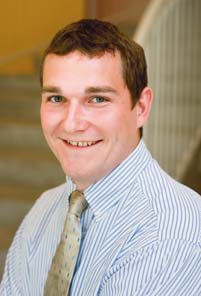This is the latest in a series of profiles of our MIT Energy Fellows—graduate students who are supported by MIT Energy Initiative (MITEI) members to participate in faculty-led research and become part of a long-term community of students and alumni.

There’s a lot going on inside a battery. Making sure it all works smoothly and efficiently could help the next generation of battery-powered cars zoom ahead to play a key role in a de-carbonized future transportation system.
“In electric cars, you really want high power output and quick recharge time. You want to get the power you need to accelerate,” said Todd R. Ferguson. “This all depends on good energy storage materials.” Ferguson, one of 40 MIT Energy Fellows, is sponsored by MITEI sustaining member Enel Produzione SpA, Italy’s largest power company, a producer, distributor, and seller of electricity and gas.
Electric cars and consumer electronics are pegging their future on rechargeable lithium-ion batteries, in which a lithium ion moves between two electrodes, the battery’s anode and cathode. Researchers are experimenting with a variety of materials for electrodes to see which ones help the batteries generate the most power, recharge the fastest, and degrade the least.
At the moment, there’s no simple way to model batteries to better understand their processes and see if they’re operating at optimal levels. Ferguson is working to change that.
In the laboratory of Martin Z. Bazant, associate professor of chemical engineering, Ferguson is creating a computer model for lithium batteries that, he hopes, will point to new ways to modify battery technology, design, and materials. The model could “eliminate areas that shouldn’t be focused on, and point toward potentially small modifications that will boost the battery’s performance and efficiency,” he said.
The goal is a battery that achieves the maximum potential for its given materials while minimizing losses. The problem is, there are always losses.
A power boost
In Li-ion batteries, a lithium ion moves from the anode to the cathode during discharge and in reverse when recharging. The flow of lithium ions out of the battery’s anode and into its cathode places stresses on their materials that can affect the lifetime and performance of the battery.
As the battery discharges, mechanical stresses such as cracks and deformations occur, hindering performance. In addition, the electrode materials, for example lithium iron phosphate or lithium cobalt oxide, degrade as the battery is charged and discharged.
Researchers are seeking new materials that will hold up better under these stresses. Even a minute improvement could translate into a faster, more efficient recharge and longer battery life.
“If we can modify current battery technology and change small things—using smaller particles of different materials in the electrodes, changing the particles’ geometries, or maybe chemical changes—we can get better results,” Ferguson said. Depending on the choice of material for the anode, cathode, and electrolyte, the voltage, capacity, life, and safety of a lithium ion battery can change dramatically.
For instance, MIT researchers recently announced that they had modified lithium iron phosphate to allow electrons and ions to move into and out of it much more quickly. The material is not new—the researchers simply changed the way they make it—but this tweak could result in batteries that discharge in 10 seconds versus a minute and a half, paving the way for rapid bursts of power.
“It’s hard to model the voltage versus the capacity with so many processes going on at once. Chemical diffusion of ions and other processes all come together to produce voltage at a certain current,” Ferguson said. “The model might show how enhancing diffusion in one area of the battery affects how the battery discharges.”
The model plots on a graph the voltage of the battery against the capacity, using existing thermodynamic and experimental data. The ideal scenario—a battery generating its highest possible voltage over time—would have a capacity equal to that of the theoretical capacity. Internal limitations in the battery lead to drop-offs in voltage and prevent the battery from reaching its maximum capacity.
While researchers often use experiments to determine a battery’s performance, Ferguson said, the model will reveal the inner workings of the battery and help researchers determine which parts of the battery are limiting the battery’s capacity.
A future in energy
As a student at Rensselaer Polytechnic Institute (RPI) in Troy, NY, Ferguson thought at first he would major in biotechnology. He even did research on controlled drug delivery systems for multiple sclerosis. But while growing up in nearby Albany, Ferguson was the kind of kid who asked a lot of questions about how things worked—often while he was busy taking them apart and putting them back together. “My parents always knew I would be an engineer,” he said.
Once Ferguson acknowledged that engineering was his calling, he wasn’t sure which discipline to pursue until he happened to hear MIT chemist Daniel Nocera speak at RPI. Nocera is working on making unlimited hydrogen from the sun by doing what plants do. “I started seeing energy as the future of where technology is going,” Ferguson said. Graduating with honors in 2008 with a bachelor of science in chemical engineering, he heard that MIT was investing money and time in energy research and education, and he decided to apply.
So far, Ferguson is pleased with the program. “In my department, there are quite a few researchers working on these (energy-related) problems, so there’s a good array of different problems to work on,” he said. When Bazant moved from the math department to chemical engineering in November 2008, Ferguson thought his strong math and computation background would be “a good fit” for Bazant’s modeling research.
Ferguson is motivated by his potential contribution not only to future cars and electronics but also to the future of the planet. “Within 50 to 100 years, we’re going to need to solve a lot of problems related to energy,” he said. “The entire world is depending on us solving them.”